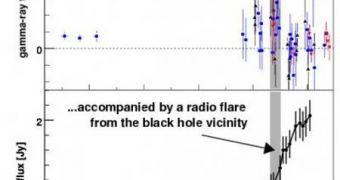In one of the largest astronomical collaborations to date, 390 scientists and four telescope arrays contributed to analyzing the very-high-energy (VHE) gamma radiation coming in from the highly active radio galaxy Messier 87, or M87. The bursts were accompanied by a strong rise of the radio flux, which the extensive team identified as coming in directly from areas around the supermassive black hole at the core of M87.
Among the three 12-meter to 17-meter telescope arrays that participated in the new study, the Very Energetic Radiation Imaging Telescope Array System (VERITAS) played arguably the most important role. In addition to the three gamma-ray observatories, the scientific effort also used the Very Long Baseline Array (VLBA) for its investigations. The latter is able to identify radio wave sources with minute precision, despite massive distances.
“We had scheduled gamma-ray observations of M 87 in a close cooperative effort with the three major gamma-ray observatories VERITAS, H.E.S.S. and MAGIC, and we were lucky that an extraordinary gamma-ray flare happened just when the source was observed with the VLBA and its impressive spatial resolving power,” one of the coordinators for the cooperative project, Matthias Beilicke, PhD, explains. He is a postdoctoral research associate in physics at the Washington University in the St. Louis School of Arts and Sciences.
“Only combining the high-resolution radio observations with the VHE gamma-ray observations allowed us to locate the site of the gamma-ray production,” National Radio Astronomy Observatory staff scientist R. Craig Walker, PhD, from Socorro, New Mexico, adds. The new research, which was led by Beilicke and UW Associate Professor of Physics Henric Krawczynski, PhD, appeared in the July 2nd issue of Science Express, the advanced online publication of the journal Science.
Also involved in the study were the Namibia, Africa-based High Energy Stereoscopic System, as well as Major Atmospheric Gamma-Ray Imaging Cherenkov (MAGIC) gamma-ray observatory, from La Palma, Spain. Their readings, and those obtained by VERITAS, were made whole by data collected from the largest and sharpest telescope in the world, the VLBA, which spans from Hawaii to the Virgin Islands, and covers some 5,000 miles of virtual lens space.

 14 DAY TRIAL //
14 DAY TRIAL //